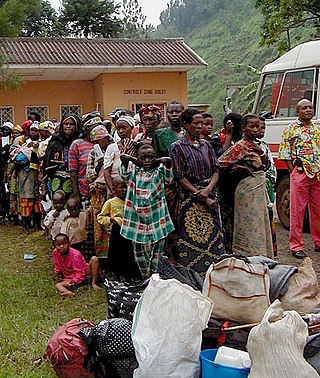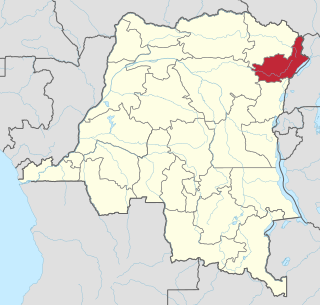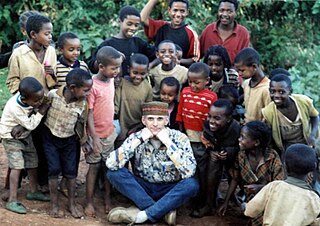Related Research Articles
There are a number of systems of transport in Burundi, including road and water-based infrastructure, the latter of which makes use of Lake Tanganyika. Furthermore, there are also some airports in Burundi.
The Hutu, also known as the Abahutu, are a Bantu ethnic or social group which is native to the African Great Lakes region. They mainly live in Rwanda, Burundi and the eastern Democratic Republic of the Congo, where they form one of the principal ethnic groups alongside the Tutsi and the Great Lakes Twa.
The Tutsi, or Abatutsi, are an ethnic group of the African Great Lakes region. They are a Bantu-speaking ethnic group and the second largest of three main ethnic groups in Rwanda and Burundi.

The White Nile is a river in Africa, one of the two main tributaries of the Nile, the other being the Blue Nile. The name comes from the clay sediment carried in the water that changes the water to a pale color.

Juvénal Habyarimana was a Rwandan politician and military officer who served as the second president of Rwanda, from 1973 until 1994. He was nicknamed Kinani, a Kinyarwanda word meaning "invincible".
Kinyarwanda, Rwandan or Rwanda, officially known as Ikinyarwanda, is a Bantu language and a dialect of the Rwanda-Rundi language that is spoken in Rwanda and adjacent parts of Burundi, the Democratic Republic of the Congo, Uganda and Tanzania. Kinyarwanda is universal among the native hearing population of Rwanda. The mutually intelligible Kirundi dialect is the national language of neighbouring Burundi. Kinyabwishya and Kinyamulenge are mutually intelligible dialects spoken in North Kivu and South Kivu provinces of neighbouring DR Congo.

The Second Congo War, also known as the Great War of Africa or the Great African War and sometimes referred to as the African World War, began in the Democratic Republic of the Congo in August 1998, little more than a year after the First Congo War, and involved some of the same issues. The war officially ended in July 2003, when the Transitional Government of the Democratic Republic of the Congo took power. Although a peace agreement was signed in 2002, violence has continued in many regions of the country, especially in the east. Hostilities have continued since the ongoing Lord's Resistance Army insurgency, and the Kivu and Ituri conflicts. Nine African countries and around twenty-five armed groups became involved in the war.

The East African Community (EAC) is an intergovernmental organisation composed of seven countries in the Great Lakes region of East Africa: the Democratic Republic of the Congo, the United Republic of Tanzania, the Republics of Kenya, Burundi, Rwanda, South Sudan, and Uganda. Évariste Ndayishimiye, the president of Burundi, is the current EAC chairman. The organisation was founded in 1967, collapsed in 1977, and was revived on 7 July 2000.

The Hema people or Bahema (plural) are an ethnic group of Nilotic origin who are concentrated in parts of Ituri Province in the eastern Democratic Republic of the Congo.
Kiga people, or Abakiga, are a Bantu ethnic group native to south western Uganda and northern Rwanda.

Also known as muzungu, mlungu, musungu or musongo, mzungu is a Bantu word that means "wanderer" originally pertaining to spirits. The term is currently used in predominantly Swahili speaking nations to refer to white people dating back to 18th century. The noun Mzungu or its variants are used in Kenya, Tanzania, Uganda, Malawi, Rwanda, Burundi, Democratic Republic of the Congo, Comoros, South Africa, Zimbabwe, Mayotte, Zambia and in Northern Madagascar dating back to the 18th century.
The Jita are a Bantu ethnolinguistic group based in Mara Region in northern Tanzania, on the southeastern shore of Lake Victoria. In 2005 the Jita population was estimated to number 205,000. The Jita have many clans such as the Rusori clan, Batimba clan, and Bagamba clan.

The Banyarwanda are the cultural, tribal and linguistic group of people who inhabit mainly Rwanda. Some Banyarwanda live in the Democratic Republic of the Congo, having migrated there from neighbouring Rwanda in waves, usually settling in the provinces of North Kivu and South Kivu.
There are several planned railway lines in Rwanda, including a line to Tanzania. Historical railways are limited to three industrial railways.
The Madhvani Group of Companies commonly referred to as the Madhvani Group, is one of the largest conglomerates in Uganda. The group has investments in Kenya, Uganda, Rwanda, South Sudan, Tanzania, the Middle East, India, and North America.

Kinyarwanda is the national language of Rwanda, and the first language of almost the entire population of the country. It is one of the country's official languages alongside French, English, and Swahili. Rwandan Sign Language is used by the educated deaf population. As a slang, the younger population in Rwanda prefers to mix French with Kinyarwanda in a pidgin like way, with Kinyarwanda being the dominant influence in the pidgin.
Ugandan Sign Language (USL) is the deaf sign language of Uganda. Uganda was the second country in the world to recognize sign language in its constitution, in 1995. A Ugandan Sign Language Dictionary has been published. However, knowledge of USL is primarily urban, as access to education for the rural deaf remains poor. Nonetheless, USL is a highly valued element of group identity among the deaf community.
The Kenya–Uganda–Rwanda Petroleum Products Pipeline is a pipeline that carries refined petroleum products from the Kenyan port city of Mombasa to the country's capital of Nairobi and continues to the town of Eldoret in the Eastern Rift Valley. There are plans to extend the pipeline to Uganda's capital, Kampala, continuing on to Rwanda's capital, Kigali.
Kabale–Kisoro–Bunagana Road is a road in Western Uganda, connecting the towns of Kabale with the towns of Kisoro, Bunagana, at the border with the Democratic Republic of the Congo and Kyanika at the border with Rwanda.
Kawanda–Birembo High Voltage Power Line is a high voltage electricity power line, under construction, connecting the high voltage substation at Kawanda, in Uganda to another high voltage substation at Birembo, in Rwanda.
References
- ↑ Rwandan Sign Language at Ethnologue (25th ed., 2022)
- ↑ Rwanda: Experts Begin Compilation of Sign Language Dictionary, The New Times, 2015 March 10